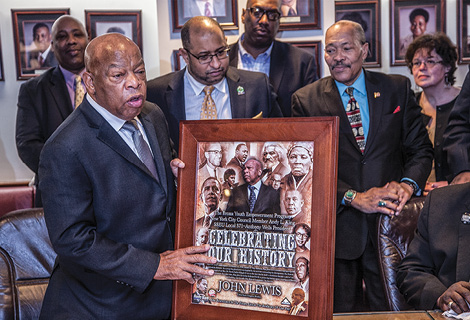Public Employee Press
Making good trouble

Unwavering conviction and a plea from Dr. Martin Luther King Jr. led young John Lewis to place himself at the forefront of the struggle against ugly racism in America. The son of sharecroppers was born in 1940 Pike County in rural Alabama. From an early age Lewis always questioned the legitimacy of Jim Crow.
“My elders told me, ‘Don’t get in trouble,’” Lewis said. No doubt they held their advice as a protection. But Lewis discerned there was trouble — and there was good trouble. “At 15, I heard about Rosa Parks and I was inspired by the Montgomery boycott,” he said.
Lewis left the 110-acre farm his parents purchased in 1944 for $300 to visit the town library in Troy. It was 1956. He was denied a library card. “The public library was for whites only,” he said, “so I never went back— until 1998, when they gave me my card.”
An 18-year-old Lewis wrote King from Fisk University and in response King sent a Greyhound bus ticket. On meeting Lewis, King gave him the moniker “the boy from Troy,” he said. And King with Ralph Abernathy and others tutored Lewis in the ways of nonviolent resistance, a hallmark of America’s civil rights movement.
Lewis organized peaceful sit-ins at segregated lunch counters in Nashville and faced angry mobs, white supremacists and Klansmen.
“They’d spit on us, poured hot coffee on us and put their cigarettes out in our hair and down our backs,” he said, recounting the senseless cruelty Southern whites inflicted. Lewis and hundreds of others—black and white— stood for change and were beaten by police for challenging racist Jim Crow laws that disenfranchised blacks, segregated interstate travel and dining, prohibited miscegenation and ghettoized education, employment, health care and housing.
We’re not going back!
By summer of 1961, Lewis rode the Freedom buses in seats reserved for whites only. Two years later he helped form the Students for Nonviolent Coordinating Committee (SNCC). Lewis, at 23, was one of the leading architects of the 1963 March on Washington for Jobs and Justice.
On a still Sunday morning, March 7, 1965, Lewis and Hosea Williams of the Southern Christian Leadership Conference, led 600 peaceful protesters on a walk for voting rights from Selma to the capitol steps in Montgomery.
“I wanted to look fresh, so I bought a used suit for $5,” Lewis recalled. “We disturbed the order of things. We speak with our feet and our hands when we march. I almost died on that bridge.”
They were blocked at the Pettus Bridge crossing by violent white mobs and state troopers. Bloodied and beaten, Lewis sustained a concussion. Photographers and television cameras shone light on Bloody Sunday and 48 million watched the national embarrassment of racism on television. That confrontation pressured President Lyndon B. Johnson to pass the Voting Rights Act of 1965.
“We cannot forget the distance we’ve come in laying down the burden of race,” Lewis said. “Anything worth having is hard. Push back. Never give up. Don’t be silent. Make good trouble.”
Arrested and jailed some 40 times, Lewis risked life and limb for civil rights, human rights and most recently for immigrant rights.
“We saw the historic Women’s March in January, and the airport protests,” Lewis told the DC 37 audience. “People are standing up. This is the time for organized labor to stand up and speak up!”
“Today it’s not as hard as it was back then,” Lewis said. “There are forces in D.C. that want to take us back. But we’re not going back! We’ve come too far!”
“Don’t worry and don’t despair,” said Lewis, 77.
Like a five-star general he urged DC37: “Keep moving. Make it uncomfortable for those who would take us back. And vote—it is a sacred tool. Some gave their lives, I gave a little blood. Be bold and unafraid. I’ve given you your marching orders.”


